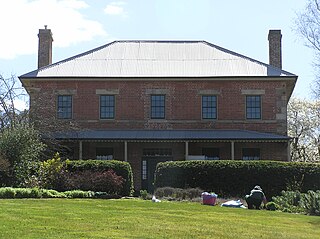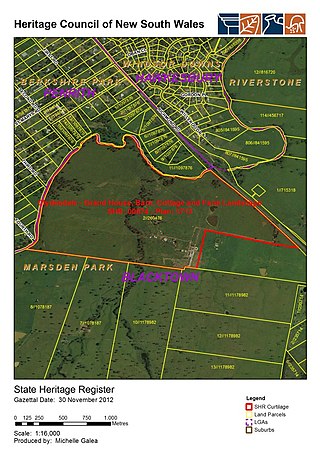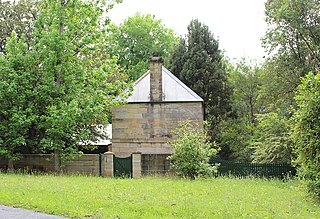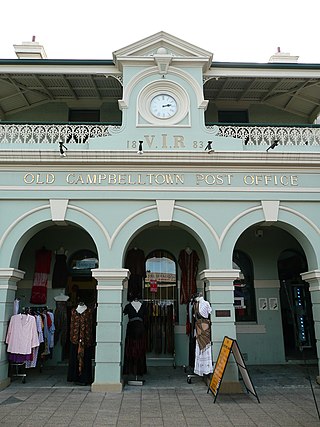
Harper's Mansion is a heritage-listed house and now house museum in Berrima, Wingecarribee Shire, New South Wales, Australia. It is recognised for its Georgian design. Harper's Mansion is now a property of the National Trust of Australia (NSW), which acquired it in 1978. It was added to the New South Wales State Heritage Register on 1 March 2002.

Clydesdale is a heritage-listed homestead and former seminary and missionary school (1859–71) and wartime hospital (1942–44) at 1270 Richmond Road, Marsden Park, City of Blacktown, New South Wales, Australia. It was built from 1823 to 1885. It is also known as Lang's Farm; the northern half is also known as Echovale. It was added to the New South Wales State Heritage Register on 2 April 1999.

Bella Vista is a heritage-listed residence at Elizabeth Macarthur Drive, Bella Vista, The Hills Shire, New South Wales, Australia. It was built from 1830 to 1960. It is also known as Kings Langley, Stock Farm, Seven Hills Farm and Bella Vista Farm. The property is owned by The Hills Shire Council and was added to the New South Wales State Heritage Register on 2 April 1999.

Riverview House is a heritage-listed former orchard and now residence at 135 Marsden Road, West Ryde in the City of Ryde local government area of New South Wales, Australia. It was built from 1860 to 1878 by George Spurway. The property is privately owned. It was added to the New South Wales State Heritage Register on 2 April 1999.

Hambledon Cottage is a heritage-listed former residence and now house museum at 47 Hassall Street, Harris Park, City of Parramatta, Sydney, New South Wales, Australia. The cottage was built from 1821 to 1825, with the initial section being designed by Henry Kitchen. It is also known as Firholme, Valley Cottage and Macarthur Cottage. The property is owned by Parramatta City Council. It was added to the New South Wales State Heritage Register on 21 September 2012.

Kelvin is a heritage-listed residence at 30 The Retreat, Bringelly, City of Liverpool, Sydney, New South Wales, Australia. It was built from 1820 to 1826 by Thomas Laycock. It is also known as Retreat Farm, The Retreat, Thomas Laycock's Cottage Vale and Cottage-ville. It was added to the New South Wales State Heritage Register on 2 April 1999.
Challoner Cottage is a heritage-listed former children's home dormitory at 82 Bong Bong Road, Renwick, in the Southern Highlands region of New South Wales, Australia. It is also known as Cottage No. 12 or the Old Dormitory Building. It is a surviving feature of the institution variously known as the Mittagong Training School for Boys and Mittagong Farm Home, State Ward Home or Children's Home. It was added to the New South Wales State Heritage Register on 28 March 2014.
White Horse Inn is a heritage-listed former residence, inn, bank and restaurant at Market Street, Berrima, Wingecarribee Shire, New South Wales, Australia. It was built from 1834 to 1850 by Edward Davies. It is also known as Commercial Bank of Australia, Rosebank, Oldbury's Inn, Holsberry Inn, Mail Coach Inn, and Royal Mail Coach Inn. It was added to the New South Wales State Heritage Register on 2 April 1999.
Mail Coach Inn is a heritage-listed former inn and residence at 24 Jellore Street, Berrima, Wingecarribee Shire, New South Wales, Australia. It was built from 1833 to 1841. It is also known as the Royal Mail Coach Inn. It traded in recent times as a now-closed bed and breakfast known as the Coach and Horses Inn; however, that name historically referred to a different Berrima hotel. It was added to the New South Wales State Heritage Register on 2 April 1999.

Macquarie Grove is a heritage-listed former airport administration offices and private residence and now private residence located at Aerodrome Road, Cobbitty, in the south-western Sydney suburb of Camden in the Camden Council local government area of New South Wales, Australia. It was built from 1812 to 1850. The property is privately owned. It was added to the New South Wales State Heritage Register on 2 April 1999.

Denbigh is a heritage-listed former vineyard, Clydesdale horse stude, Ayrshire cattle stud and dairy farm and now Hereford stud located at 421 The Northern Road in the southern-western Sydney suburb of Cobbitty in the Camden Council local government area of New South Wales, Australia. It was built during 1818 by Charles Hook in c. 1818 and by Thomas and Samual Hassall, and Daniel Roberts in c. 1828. The property is privately owned. It was added to the New South Wales State Heritage Register on 22 December 2006.

Goldfinders Inn is a heritage-listed former inn, guesthouse, general store and post office and now residence at 164 Old Bells Line of Road, Kurrajong, City of Hawkesbury, New South Wales, Australia. It was built from 1809 to 1830 by John Lamrock. It is also known as Gold Finders Rest, Kurrajong General Store and Kurrajong Post Office. It was added to the New South Wales State Heritage Register on 21 October 2016.

Macquarie Arms Inn is a heritage-listed former inn and now residence at 104-106 Bathurst Street, Pitt Town, City of Hawkesbury, New South Wales, Australia. It was also known as the Blighton Arms and Flemings Public House in its time as an inn, while the main house on the property became known as Mulgrave Place. It was added to the New South Wales State Heritage Register on 2 April 1999.

Hartley historic site is a heritage-listed historic village located adjacent to the Great Western Highway, Hartley, City of Lithgow, New South Wales, Australia. It was built from 1837 to 1850. It is also known as Hartley Historic Site and Hartley Township. The property is owned and protected by Office of Environment and Heritage, an agency of the Government of New South Wales. It was added to the New South Wales State Heritage Register on 2 April 1999.

The Campbelltown Post Office is a heritage-listed former post office and now shops and office space at 261 Queen Street, Campbelltown, New South Wales, a suburb of Sydney, Australia. It was designed by James Barnet and built in 1881. It is also known as Campbelltown Post Office (former). The property is privately owned. It was added to the New South Wales State Heritage Register on 2 April 1999.

Holly Lea and Plough Inn is a heritage-listed site at Holly Lea Road, Leumeah in the City of Campbelltown, New South Wales, Australia. The heritage listing includes a former residence, an inn and a storage shed. It was built from 1816 by William Ray. It is also known as Plough Inn; Three Brothers (inn); The Travellers' Home (inn); Borobine House; Hollylea; and William Ray's Cottage Inn Coolroom. The property is privately owned. It was added to the New South Wales State Heritage Register on 2 April 1999.

The 203–205 Albion Street, Surry Hills Cottages are two heritage-listed cottages located at 203–205 Albion Street in the inner city Sydney suburb of Surry Hills in the City of Sydney local government area of New South Wales, Australia. It was built in 1840 by George Hill. The property is owned by the Royal College of Pathologists of Australasia. It was added to the New South Wales State Heritage Register on 2 April 1999.
Wambo Homestead is a heritage-listed disused homestead at Warkworth, Singleton Council, New South Wales, Australia. It was built from 1830 to 1906. It was added to the New South Wales State Heritage Register on 2 April 1999.

Samson's Cottage wall remains is a heritage-listed former residence and now retail building located at 8 Kendall Lane, in the inner city Sydney suburb of The Rocks in the City of Sydney local government area of New South Wales, Australia. It was built for William Samson in 1844. It is also known as Samson's Cottage (wall remains) and Puppet Cottage (Samsons). The property is owned by Property NSW, an agency of the Government of New South Wales. It was added to the New South Wales State Heritage Register on 10 May 2002.
White Hart Inn Archaeological Site is a heritage-listed inn and archaeological site at Windsor Road, Beaumont Hills in The Hills Shire local government area of New South Wales, Australia. It was built from 1827 to. The property is owned by NSW Department of Planning, Industry and Environment, a department of the Government of New South Wales. The site was added to the New South Wales State Heritage Register on 24 August 2018.
















